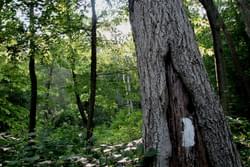




Best practices for blaze marking along trails

There are several ways of marking trails: paint, carvings, affixed markers, posts, flagging, cairns, and crosses, with paint being the most widely used. Waymarking with signs, or other markers, is used in non-forested landscapes, and in outdoor recreational areas.
Be sure you're clear on why and where you need blazes or markers. Is this an extremely primitive trail that is easy to lose? In deep, rocky woods where there is not much of a trail tread, or where snow persists until summer, it makes more sense. Use a Carsonite post with a trail logo and arrow, if needed, just in the occasional places people need some wayfinding help: a junction, a fork, or some other place where topography makes the route uncertain.
In Pennsylvania and other states, trails are typically marked with various signs and painted patches on trees and posts, called blazes. Most blazes will be painted on trees or sign posts. On occasions blazes can be painted onto rocks.
The Pennsylvania Department of Conservation and Natural Resources (DCNR), has set guidelines for marking trails on state forest land. These guidelines are typically followed on state game lands as well as within state parks. Pennsylvania DCNR has guidelines for both motorized and non-motorized trails. Motorized trail blazes are in the shape of diamonds while blazes for non-motorized trails are in the shape of rectangles, measuring 2" x 6".
The standard blaze colors set forth by DCNR are red, yellow, blue, and orange. Red blazes are used to mark shared-use trails. Shared-use trails are open to horseback, mountain bike and foot travel. Trails designated as state forest hiking trails are blazed in orange. These trails are intended to be for foot travel only. Cross-country ski trails are marked with blue blazes. These trails are also typically marked with the international symbol of a white skier on a brown background, posted at the trailhead. Finally, local hiking trails are blazed in yellow. Trailheads and major intersections may be marked with the international symbol of a hiker on a brown trailhead, indicating the trail to be used for foot travel only.
When crossing large talus slopes or fields, rock cairns can also be used to mark the route of the trail. Cairns are carefully arranged piles of stones. It is important not to build rock cairns along trails, or disassemble exiting cairns, as this may cause confusion to those hiking the trail. Cairns are most commonly used to indicate trails in open areas, such as higher-elevation alpine areas, where no trees are available, or where conditions may make blazes hard to see.
Alternatively, more long lasting plastic, metal or even sometimes wooden markers may be affixed to trees, usually with nails. The placement of these markers requires more skill and labor than paint, as well as an area with an abundant supply of trees to which to attach them.
Below are a few useful resources. Our resource library contains many articles on wayfinding, signage, cairns and other trail marking topics.
posted May 24, 2021
Are there any graduate programs that are focused on trail planning, development, and design?
FAQ: Apps for Trail Management and Volunteers
posted May 19, 2021
Information on apps that can be used for trail management that would be suitable for volunteer-type organizations.
FAQ: What is the definition of a trail?
posted Jan 14, 2021
Defining a trail corridor in law, policy, and planning.
20,464 views • posted 08/02/2018